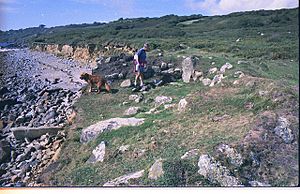Coverack to Porthoustock facts for kids
| Site of Special Scientific Interest | |

Trebarveth salt works along the shore of the SSSI
|
|
| Area of Search | Cornwall |
|---|---|
| Coordinates | 50°02′05″N 5°04′37″W / 50.0347°N 5.0769°W |
| Interest | Biological/Geological |
| Area | 173.46 hectares (1.735 km2; 0.6697 sq mi) |
| Notification | 1951 |
Coverack to Porthoustock is a special coastal area in Cornwall, England, UK. It's known as a Site of Special Scientific Interest (SSSI) because it has amazing plants and interesting rocks. This area is home to four very rare plant species.
Contents
What is the Coverack to Porthoustock SSSI?
This special area covers about 173.5 hectares (that's like 428 football fields!). It was first recognized as an SSSI in 1951. You can find it on the south coast of Cornwall, on a piece of land called the Lizard Peninsula.
The SSSI stretches along the coast from the village of Coverack in the south. It follows the shoreline of the English Channel all the way up to the small village of Porthoustock in the north.
Walking the Coast Path
The famous South West Coast Path goes right through this SSSI. This path lets you explore the beautiful coastline. Some parts of the coast, especially around Lowland Point, are looked after by the National Trust. This organization helps protect important natural and historical places.
Rare Plants and Wildlife
The coastline here is home to some very special plants. Four of these plants are listed in the Red Data Book. This means they are rare or endangered and need protection.
These rare plants include:
- Cornish heath (Erica vagans)
- Dwarf rush (Juncus capitatus)
- Twin-headed clover (Trifolium bocconei)
You can also find the nationally scarce autumn squill (Scilla autumnalis) here. It's not as rare as the others, but it's still uncommon in the UK.
Ancient Saltworks at Trebarveth
This area has a fascinating history! On a "raised beach" (an old beach that's now higher than the sea) between Pedn-myin and Lowland Point, you can find the remains of an ancient salt factory. This factory, called the Trebarveth saltworks, was used by the Romano-British people way back in the 2nd century.
How Salt Was Made
The main rock in this area is called Gabbro. When it breaks down, it turns into a rough clay. The people living here used this clay to make pots.
They would boil seawater in two rectangular stone ovens. These ovens were inside an oval-shaped building. After the water evaporated, they were left with salt. This salt was then packed into the clay pots.
You can still find pieces of these old, red pottery pots (called "briquetage") in the nearby cliffs. Some even have the fingerprints of the potters who made them! Each oven was about 150 cm long and 40 cm wide. If they filled it with pots, they could boil about 50 liters of seawater at a time. Since seawater contains about 3% salt, each time they boiled water, they would get about 1.5 kg of salt.
The saltworks are part of an old field system, and some of the stone walls from those fields still stand up to 1 meter high today.

